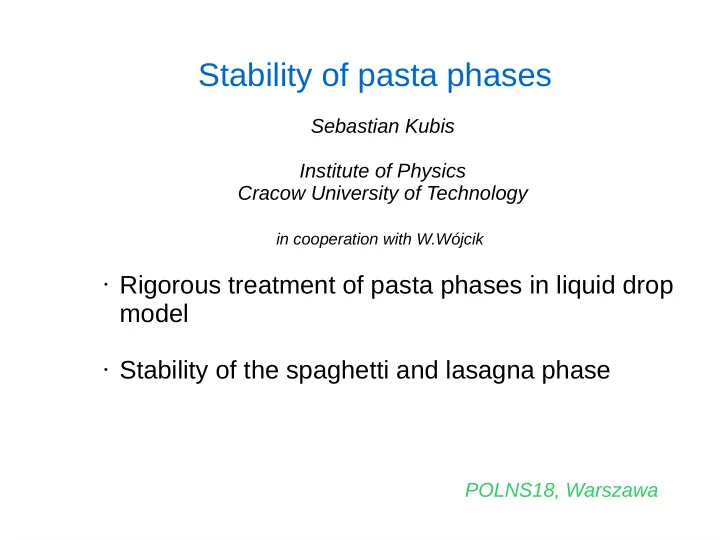

Stability of pasta phases Sebastian Kubis Institute of Physics Cracow University of Technology in cooperation with W.Wójcik • Rigorous treatment of pasta phases in liquid drop model • Stability of the spaghetti and lasagna phase POLNS18, Warszawa
Neutron star structure atmosphere (ionized light elements: C , O, .. ) e – degeneracy, Coulomb crystal of nuclei neutronization of nuclei neutron drip → exotic nuclei - proton clusters in quasi-free neutron liquid cluster deformation → pasta phases cartoon by W.G.Newton
Pasta appearance in the crust-core transition region Ravenhall, Pethick 1983 proton clusters in neutron gas = sharp boundary between two phases with opposite charge contribution from surface and Coulomb energy d= 3 - gnocchi d= 2 - spaghetti d= 1 - lasagna
Pasta appearance in the crust-core transition region Ravenhall, Pethick 1983 proton clusters in neutron gas = sharp boundary between two phases with opposite charge contribution from surface and Coulomb energy d= 3 - gnocchi d= 2 - spaghetti d= 1 - lasagna isolated Wigner-Seitz cell
Development in other approaches to pasta phases Hartree-Fock Periodic boundary conditions W.G. Newton '09 variety of structures… not only rods and slabs Temperature ?? Time-Dependent HF Schuetrumpf `13
Development in other approaches to pasta phases Molecular Dynamics - two body potential for pointlike particles - 50 000 nucleons in a box - temperature ~ 1 MeV - periodic boundary Horowitz '15 Schneider '13
Rayleigh-Plateau instability, 1878 perturbed cylinder volume preserving deformation L - surface energy - surface tension unstable if
surface variation under conserved volume - boundary of D, surface - normal deformation Surface area change up to the 2nd order Volume change up to the 2nd order - mean curvature - Gaussian curvature
- outward unit normal s – arc length Gaussian curvature mean curvature (internal, depends on the metric (external, depends on immersion) → Ricci scalar in GR)
instability – variation analysis conserved volume surface with constant H, for cylinder H = -1/2R L stable with respect to any deformation negative !
instability – variation analysis conserved volume surface with constant H, for cylinder H = 1/2R L stable with respect to any deformation first unstable mode Jacobi equation L – mode wavelength liquid cylinder is always unstable
CMC -surfaces Young-Laplace equation, 1805 conserved volume Constant Mean Curvature surfaces surface of revolution – axial symmetry unduloid nodoid intersections – not interesting unstable !
CMC -surfaces Young-Laplace equation, 1805 conserved volume Constant Mean Curvature surfaces unstable !
CMC -surfaces Young-Laplace equation, 1805 conserved volume Constant Mean Curvature surfaces stable CMC are: doubly periodic of genus 2 sphere the only one compact CMC genus = number of holes OR triply periodic of genus 3
shape variation of charged cluster modified Young-Laplace equation Kubis '16 modified beta-equilibrium no CMC surface! mean curvature H prescribed by pressure difference Δ P and the potential Ф
stability condition for charged cluster the cluster obeying the modified Y-L equation is it stable? the shape change → changes the potential solution of it enters only into the 2 nd order variation: Kubis '16 negative/positive ? negative contribution
spaghetti phase periodic solution cylinder: H =conts - ok not known cluster surface concides with Y-L - 2 nd order nonlinear equipotential surface problem boundary condition relevant ! single charged rod in vacuum single charged rod in W-S cell at infinity at cell boundary
spaghetti phase (in vacuum) gyroid flattening hourglass Coulomb energy dominates Rayleigh-Plateau instability surface energy dominates cylinder is not stable for any charge density
spaghetti phase (in cylindrical W-S cell) “Virial theorem” but on volume fraction and mode wavelength for gyroid mode: highly positive! all modes are stable at all volume fraction cylindrical W-S cell too restrictive !
Looking for nontrivial shapes - stability analysis lasagna – the only one periodic solution in the CLDM y different modes for different faces z x “Virial theorem” symmetry energy does not matter ! a - cell size b, c – mode wavelengths in y, z directions only the geometry is valid !
Looking for unstable modes for the slab i- th face, k,l - modes numbers for z and y directions ● modes for z and y directions directions decouple ● two class of normal modes for any mode wavelength and volume fraction ! the slab is locally stable → no “decay” channel ?
stable modes in lasagna – transport properties acoustic “phonons” (surfons ?) for in agreement with Pethick&Potekhin ' 98 result optical “phonons” (surfons ?) more efficient energy transport
Conclusions - modified Young-Laplace equation governs the pasta shape – nonconstant mean curvature H - stability of charged cluster – nontrivial question Questions - spaghetti: stable/unstable ? periodic solution desirable ! - lasagna phase is locally stable for any volume fraction how it changes to other shapes? - new kind of excitations – "surfons" ?
Recommend
More recommend